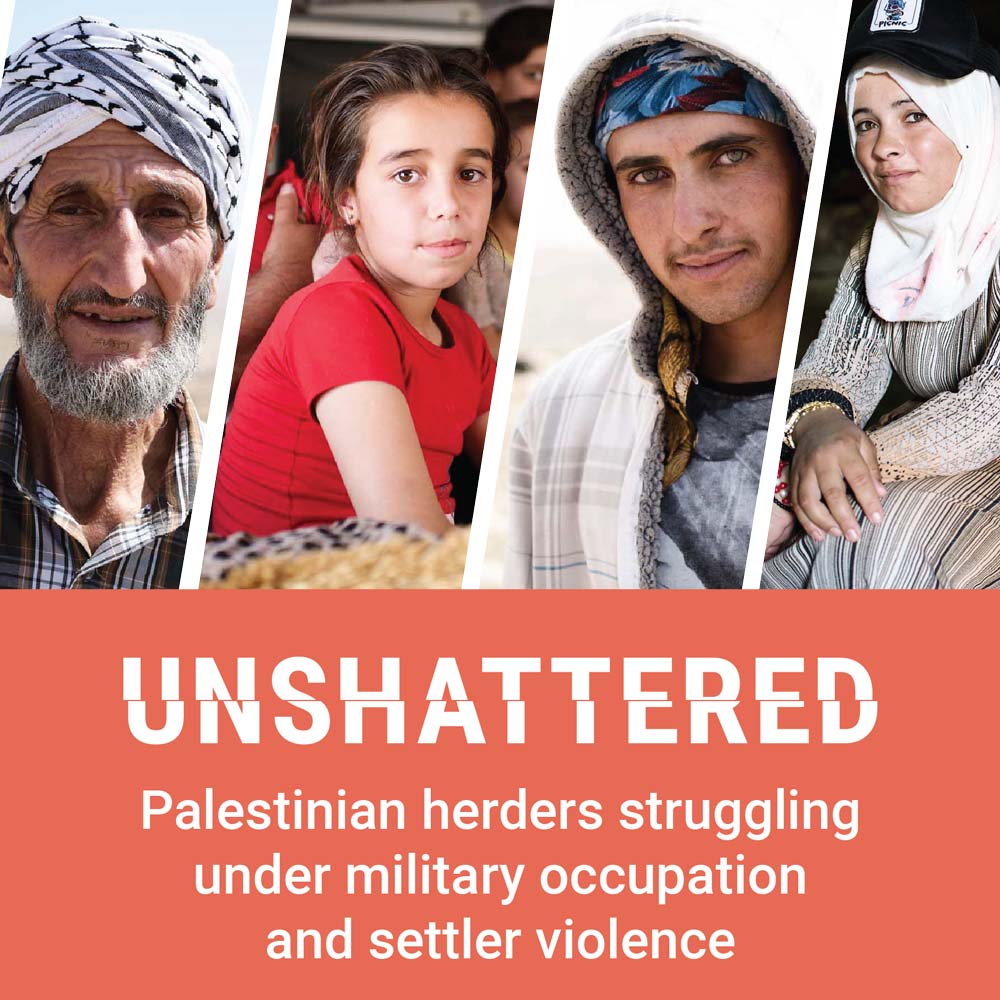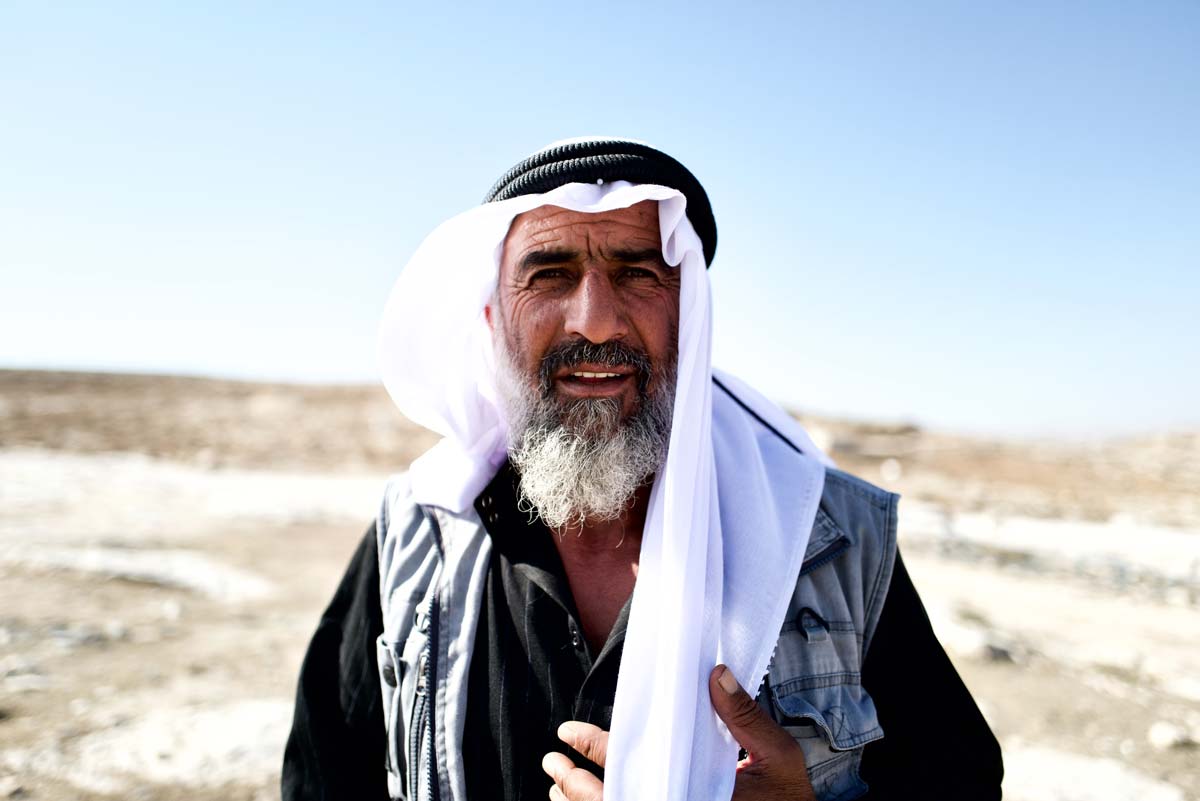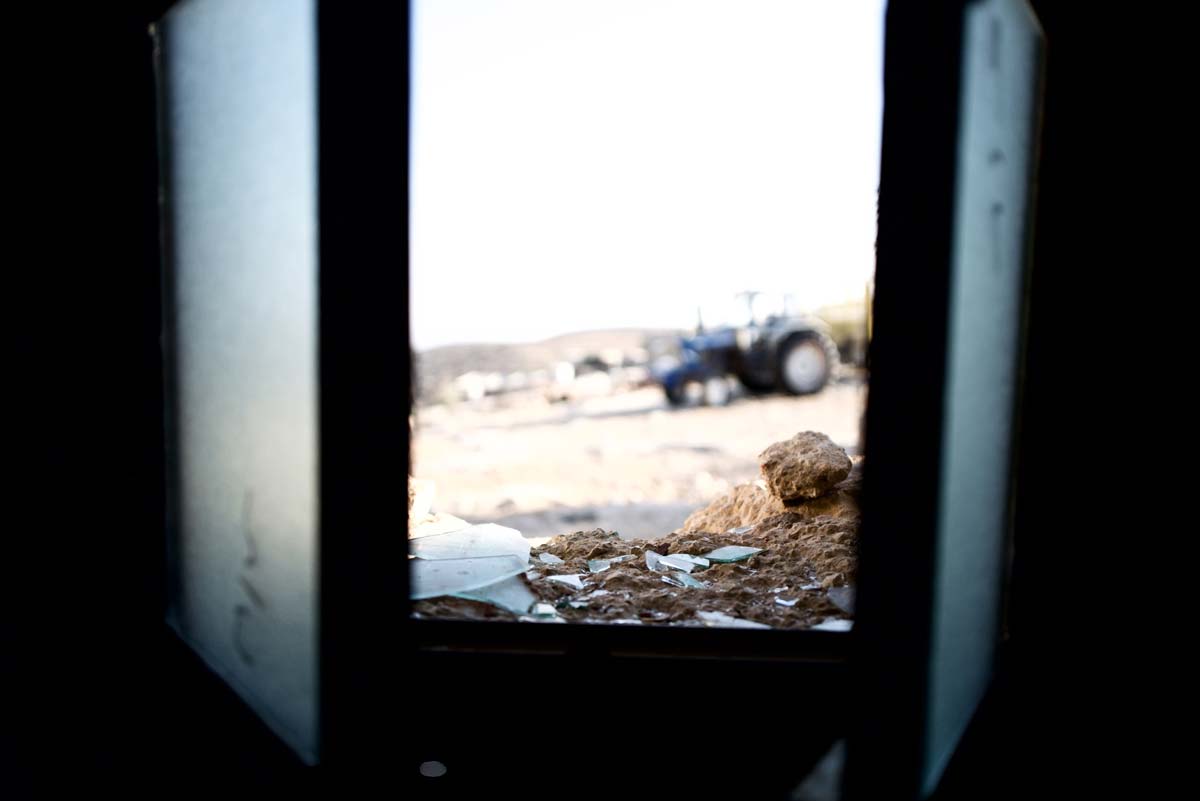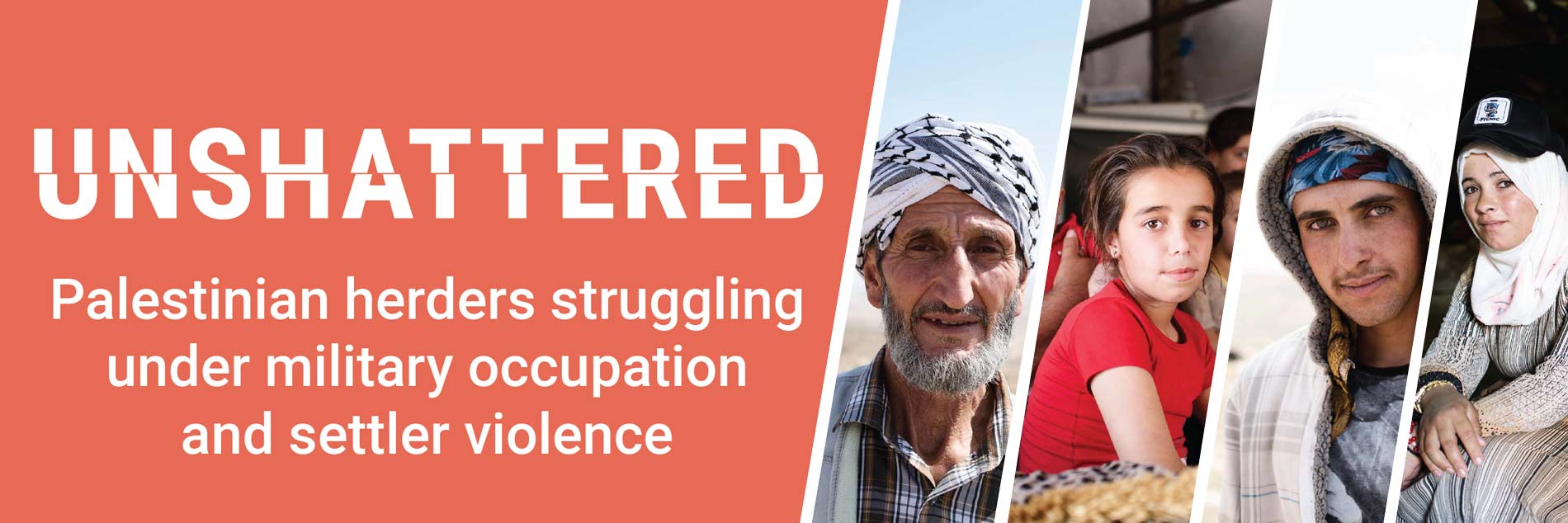Palestinians resisting forcible transfer in Masaffer Yatta
On 15 December 2021, Mahmoud Hamamdeh was out working a plot of land just outside his community of Umm Fagarah (population 100), in the southern Hebron hills. He was approached by officials from the Israeli Civil Administration (ICA), whom he believes were summoned by a settler from the nearby Avigayil settlement outpost, who had been observing and photographing him and requesting that he leave the land. The ICA officials claimed that he was encroaching on property designated as ‘state land’ and must vacate the area. Over the years, the Israeli authorities have designated large swathes of the West Bank as ‘public’ or ‘state’ land and allocated this resource almost exclusively for Israeli settlements or for military training, rather than for the benefit of Palestinian communities.
Mahmoud explained that he had been working the land since 2007, based on a lease agreement from a Palestinian landowner, who had documents proving his property rights and photographic evidence showing continuous cultivation since 1990. Neither Mahmoud, nor the landowner, had ever received an eviction order or any other notification regarding the state land declaration. However, he consented to leave the land pending further investigation, adding that he he would inform the international community about the incident. The official then notified Mahmoud that his vehicle would be immediately seized and summoned a truck to tow away his tractor, together with a plough which he had just purchased. The vehicle had only recently been repaired following a settler assault on Umm Fagarah in September (see below), when its windows were smashed and tires slashed.
Mahmoud was requested to pay about NIS 4,500 (US$1,400) for the cost of towing the tractor, whereupon the vehicle would be released, provided that he committed not to return to the land for two years. He refused so his tractor remained impounded. Mahmoud’s lawyer filed a petition at the High Court of Justice. In mid-February, the ICA agreed to release the tractor without Mahmoud paying a fine, although he had to pay for the cost of towing it back to his community. Without a tractor, he missed the opportunity of ploughing his land for the winter wheat and barley season, and renting it out to other farmers. The loss of the tractor also impaired the community’s access to markets and services, as it was used to transport goods such as water tanks as well as residents over unpaved roads and rugged terrain.
Umm Fagarah is located in the Massafer Yatta area of southern Hebron, in Area C, where a restrictive planning regime applied by the Israeli military makes it virtually impossible for Palestinians to obtain building permits, impeding the development of adequate housing, infrastructure and livelihoods. Compounding these restrictions, in the 1970s, some 30,000 dunums of the total land area of Massafer Yatta, including Umm Fagarah and 13 other small communities (population c. 1,300), were designated by the Israeli military as a closed area for military training, ‘Firing Zone 918’. Nearly 30 per cent of Area C is designated as ‘firing zones’ and the 38 Palestinian communities in these zones are among the most vulnerable in the West Bank, with limited access to education and health services, and water, sanitation, and electricity infrastructure.
These communities are also at heightened risk of eviction, despite a provision, under Israeli military legislation, allowing people who are deemed ‘permanent residents’ of declared firing zones to continue residing there. In 1999, the Israeli military evicted the residents of the 14 Palestinian communities in Firing Zone 918, claiming that they were living there on a seasonal basis and did not qualify as ‘permanent residents’, despite many of the families having documentation proving their ownership of the land going back before 1967. Over 700 people were forcibly displaced, including Mahmoud and his family, and most of their homes and property were destroyed or confiscated. “This was the worst period of my life,” Mahmoud says. “I feared that I would never return home.”
After several months, and following petitions from the residents, the Israeli High Court of Justice issued an interim injunction allowing the residents who had petitioned to return to their homes, pending a final court decision; the injunction remains in force. However, as stated in 2012, the position of the Israeli Ministry of Defence was that eight communities should be evicted.[1] The firing zone would be off-limits to the displaced communities, with exceptions made for land cultivation and grazing of livestock on certain occasions, when no military training takes place. The other four communities, including Umm Fagarah, would be permitted to remain, but prohibited from constructing additional buildings and infrastructure.
Since then, the Israeli authorities have issued demolition or ‘stop work’ orders against most of the homes, animal shelters, cisterns and community infrastructure in Massafer Yatta, including Umm Fagarah, on the grounds that they were built without building permits, leaving residents unable to expand or maintain their existing homes.[2] Between 2011 and 2021, Israeli forces demolished or seized twenty structures in the community, with the most significant incident occurring in 2011, when eight adults and 30 children were displaced, and the community’s mosque, water pumps and power generator were also demolished. Mahmoud’s house was one of those destroyed with all its possessions inside, including the books and other educational materials his daughter was using for her university exams.
Palestinians in Massafer Yatta are also affected by the ongoing encroachment of Israeli settlements, which are illegal under international humanitarian law as they violate Article 49 of the Fourth Geneva Convention, which prohibits the transfer of the occupying power’s civilian population into occupied territory. Despite this, following the designation of large tracts of land in Massafer Yatta as state land in the 1970’s, the Israeli authorities leased some of the area to the World Zionist Organization for the development of settlements. This has led to the expansion of settlements in the north, east and southeast of Massafer Yatta[3], and reduced freedom of movement for Palestinians and the space available to them for grazing the sheep and goats, which are the residents’ primary source of income. This has resulted in increased reliance on fodder, which herders are forced to buy on credit.
In addition to officially sanctioned expansion of the Carmel, Ma’on and Susiya settlements, Umm Fagarah has been also affected by three ‘unauthorized’ settlement outposts, Ma’on Farm, Avigayil and Mizpe Yair. Although these were established without government approval and lack building permits, they are connected to the water and electricity networks and are closely protected by Israeli forces. In recent years, settlers from these outposts have been expanding their control over nearby territory, including within the firing zone, and undermining the physical security of Palestinian residents through intimidation and violence.[4]
Mahmoud has experienced numerous incidents of settler violence over the years. In 2006, about 100 of his sheep were killed, poisoned, he claims, by settlers. He notes an increase in settler violence incidents in 2021[5], with the most serious incident occurring on 28 September, when Israelis from Avigayil and Ma'on Farm settlement outposts attacked the community and injured nine Palestinians. Mahmoud’s three-year-old grandson was struck on his head by a stone while in bed, and had to be taken to an Israeli hospital. The assailants also killed five sheep and damaged ten homes, 14 vehicles, including Mahmoud’s tractor, and several solar panels and water tanks. After Palestinians threw stones at the attackers, to drive them off, Israeli forces intervened by shooting stun grenades and teargas canisters at the Palestinians, 20 of whom required treatment for inhaling teargas, and by arresting several more. Israeli police arrested six settlers in connection with the incident, and an indictment had been filed against two minors. As a rule, Israeli settlers are rarely prosecuted and convicted for these attacks, increasing the level of threat to Palestinians and their property.[6]
Humanitarian organizations and donors have been providing assistance to the communities in Massafer Yatta in an effort to meet their basic needs and prevent their forcible transfer. However, the Israeli authorities are impeding these efforts by the issuance of ‘demolition’ or ‘stop work’ orders against many of the items provided, by confiscation of vehicles and equipment, and by restrictions on physical access to lands and of humanitarian workers to the area. The four schools in the area, all of which were established with support from the international community, have pending demolition orders, as do the four medical centres which are serviced by mobile health teams on a bi-weekly basis. Although a local outline plan has been produced for Umm Fagarah, which would allow for the building of essential infrastructure and new houses, this was rejected by the ICA, although an appeal submitted against its rejection is pending at the Israeli High Court of Justice.
None of the Palestinian communities in Massafer Yatta is connected to the Israeli electricity grid and residents are thus reliant on solar panels provided by international donors; most of these, especially the larger systems, have pending demolition orders. International donors have also supported projects to connect 11 of the communities to the water network. This network has been destroyed multiple times by the ICA, and repaired with international support; legal appeals against demolition orders are pending. The disruption to services results in many already vulnerable households being forced to buy tankered water from private vendors, at rates up to five times the price of piped water.
The policies and practices listed above have undermined their physical security and psycho-social health, lowered their standard of living, and increased the dependence on humanitarian aid of Palestinians in Massafer Yatta. This coercive environment generates pressure on people to leave the area, which would amount to forcible transfer – a grave breach of the fourth Geneva Convention.[7] Despite all the pressures exerted on his communities, Mahmoud is resolved not to leave. “Even though we face many problems, I will not leave. We know that we are at risk of forcible transfer, but every settler attack only strengthens my resolve and I am determined to stay put.”
* On some of the ways in which the humanitarian community supports Palestinians at risk of displacement in Masaffer Yatta, please see NRC’s article “Helping Palestinians stand up to the forces of displacement”
[1] Families in two of the original communities in Firing Zone 918 – Al Kharoubeh and Khirbet Sarura – have been driven away by settlement activity, including settler violence.
[2] On average, between 2009 and 2020, less than two per cent of the building permit applications filed by Palestinians in Area C were approved by the Israeli authorities.
[3] ‘Plans made by the Settlement Division of the World Zionist Organization affirm this pursuit by stating a “buffer zone” must be created in this area to separate the Palestinian villages in [Firing zone 918] from the Bedouin population of the Arad Valley and the Beersheba Valley inside the Green Line. B’Tselem: State Business: Israel’s misappropriation of land in the West Bank through settler violence, November 2021.
[4] “The violence, which continues to this day, consists of beating – including with sticks, axes and clubs – stone-throwing, riding horses or ATVs to scare and scatter flocks, setting assault dogs on shepherds and sheep, setting fire to fields and cutting down trees. In recent years, settlers from Havat Ma’on, like settlers in other outposts and farms around the West Bank, have been using drones to scatter flocks belonging to Palestinian shepherding communities.” B’Tselem: State Business.
[5] In 2021 OCHA documented nearly 500 attacks by Israeli settlers resulting in four Palestinian fatalities, 175 injuries and extensive property damage. This is the highest level since OCHA started recording settler-related violence in 2005, and represents a 40 and 50 per cent increase in the number of incidents compared with 2020 and 2019, respectively.
[6] According to the Israeli organization, Yesh Din, between 2017 and 2020, of 63 incidents of settler violence that they documented, 60 complaints were filed, of which Israeli police investigated only 38, with no indictment resulting. In November 2021, an Israeli settler was sentenced to 20 months in prison for throwing a stun grenade at a Palestinian home, injuring two and causing significant damage.
[7] According to the UN Secretary General, Palestinians residing in Firing Zone 918 “continue to be subjected to the Israeli regulations and policies pertaining to firing zones, increasing the pressure to move and the risk of forcible transfer”. Israeli settlements in the Occupied Palestinian Territory, including East Jerusalem, and the occupied Syrian Golan, A/76/336, 23 September 2021, para. 40.













